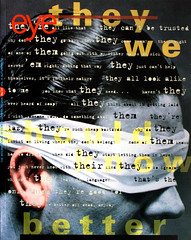Autumn 1994
First things last
Letter from Ken Garland in Eye 14
Andrew Howard’s stimulating contribution to Eye no. 13 vol. 4, ‘There is such a thing as society,’ draws on the ‘First Things First’ manifesto of 1964, for which I had some responsibility, to support his view that ‘We cannot separate our work from the social context in which it is received and from the purpose it serves.’ While the manifesto was concerned with spending priorities rather than social consciousness, the objectives listed as the more desirable options from our point of view were certainly in line with his thesis.
In adopting what appears to be a more radical position than ours, however, he takes us to task for saying, ‘We don’t advocate the abolition of high pressure advertising: this is not feasible.’ Howard sees this as a retreat, since we were arguing for no more than a larger share of the cake to be devoted to the purposes we preferred, rather than demanding a different cake altogether.
He is right to raise the point; I have, over the years, had some qualms about the pragmatic flavour of that part of the manifesto. My excuse was that although I was prepared, as a designer, to accept the socio-economic structure and contrive to modify its spending priorities whenever possible, as a citizen with a vote and a political allegiance, I could join those of like mind in advocating a more drastic social change. This personality split has served me well enough over the last 30 years, providing me with a reasonable, if modest, living on the one hand, and a reasonably clear, if not overstrained, conscience on the other.
But to what end? Neither in the confined arena of graphic design nor in the sphere of wider social concerns has there been any detectable change in priorities away from those with profit-driven, marketplace imperatives. Indeed, quite the reverse: the financial stringencies of the mid 1970s disposed of even those few crumbs from the table of the very rich that came the way of good causes; the awful 1980s, presided over by the cynical apostles of greed known as the Reagan and Thatcher governments, had no time at all for such social concerns as we espoused. Those governments and their gangster buddies in the serious money business, to whom buying and selling were more important than what is bought and sold, regarded design as no more than a handy tool for marketing.
So much for a pragmatic approach. We looked on, bemused, as some of our more prominent colleagues trooped through the doors of 10 Downing Street to be lectured by Thatcher about how we could make our little contribution to the Greed Mountain. What ignominy! What betrayal!
So thank you and curse you, Andrew Howard. Thank you for reminding us that we said something that was valid then and is valid now; and curse you for prodding our comatose consciences into painful life once more. Now what?
London
First published in Eye no. 14 vol. 4 1994
Eye is the world’s most beautiful and collectable graphic design journal, published quarterly for professional designers, students and anyone interested in critical, informed writing about graphic design and visual culture. It is available from all good design bookshops and online at the Eye shop, where you can buy subscriptions, back issues and single copies of the latest issue. You can also browse visual samples of recent issues at Eye before You Buy.


